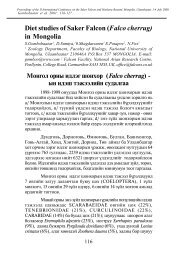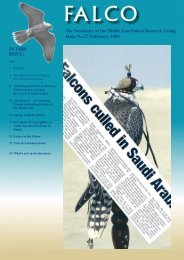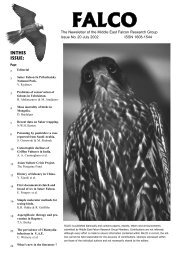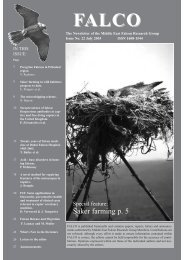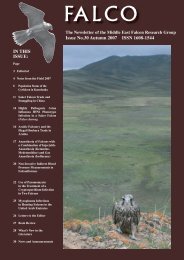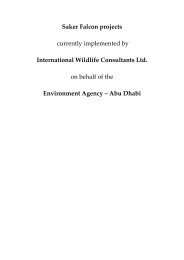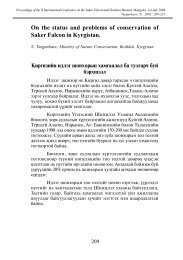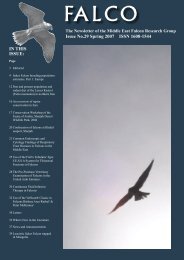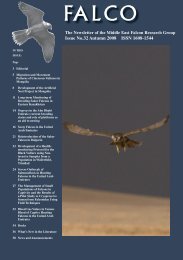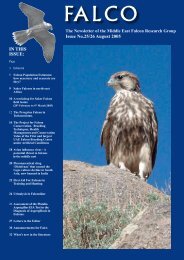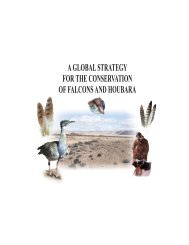Falco 28 - International Wildlife Consultants Ltd.
Falco 28 - International Wildlife Consultants Ltd.
Falco 28 - International Wildlife Consultants Ltd.
You also want an ePaper? Increase the reach of your titles
YUMPU automatically turns print PDFs into web optimized ePapers that Google loves.
capture ELISA tests are also available from different<br />
companies and the results are available within 24 to 48<br />
hours, but only indicate a positive or negative result.<br />
PCRs are also available. Serology is of less value but<br />
HIT or ELISA should be carried out for surveys or after<br />
vaccination.<br />
Prevention and Control<br />
AIV is not eradicable and prevention and control are<br />
the only realistic goals (Wernery, 2006 in prep.). The<br />
following recommendations should be initiated in the<br />
Middle East:<br />
• Monitor movements of poultry between farms<br />
and markets.<br />
• Monitor birds in live markets and exports/<br />
imports.<br />
• Improve biosecurity measures (e.g. prevent<br />
contact with wild aquatic birds).<br />
• Separate land-based poultry and aquatic avian<br />
species in farms and markets.<br />
• Close live bird markets and keep all poultry<br />
indoors while HPAIV is circulating in the region.<br />
• Conduct serological and other epidemiological<br />
studies in wild birds to determine whether HPAIV<br />
became established in wild population.<br />
• Allow controlled effective vaccination in response<br />
to virulent outbreaks.<br />
• Vaccinate valuable birds like falcons, houbara<br />
bustards, psittacines and zoo birds.<br />
So far, no H5N1 vaccine is available neither for birds<br />
nor for humans. However, H5N2 dead AI vaccines are<br />
available and should be used. It has been shown that<br />
the vaccine produces a good immune response in a<br />
number of vaccinated bird species (Oh et al., 2005),<br />
and ceased mortalities caused by H5N1 in chickens 18<br />
days after a single vaccination (Ellis et al., 2004). Birds<br />
should be boostered 4 to 6 weeks after the first injection<br />
and vaccinated annually. When H5N1 vaccines are<br />
available, they should replace the H5N2 vaccines.<br />
References<br />
Ellis, T.M., Leung, C.Y.H.C., Chow, M.K.W., Bisset, L.A., Wong,<br />
W., Guan, Y. and Peiris, J.S.M. 2004. Vaccination of chickens<br />
against H5N1 avian influenza in the face of an outbreak interrupts<br />
virus transmission. Avian Pathology. 33 (4): 405–412.<br />
Garrett, L. The next pandemic? Foreign Affairs 2005. 84 (4): 3–<br />
23.<br />
Manvell, R.J., McKinney, P., Wernery, U., Frost, K. 2000. Isolation<br />
of a highly pathogenic influenza A virus of subtype H7N3 from<br />
a peregrine falcon (<strong>Falco</strong> peregrinus). Avian Pathology. 29: 635<br />
– 637.<br />
Munster, V.J., Wallensten, A., Baas, Ch. et al. 2005. Mallard and<br />
highly pathogenic avian influenza ancestral viruses, Northern<br />
Europe. CDC Emerging Inf. Dis. 11 (10) in print.<br />
Oh, S., Martelli, O.S., Hock, S., Luz, C., Furley, C., Chiek, L, Wee,<br />
Ch. and Kenn, Ng. M. 2005. Field study on the use of inactivated<br />
20<br />
H5N2 vaccine in avian species. Veterinary Record. 157 (10): 299–<br />
300.<br />
Promed 2005. Avian influenza-Eurasia 49: wild birds, promed@<br />
promed.isid.havard.edu. Thursday, Nov. 3.<br />
Spielman D., Mauroo, N., Kinoshita, R. et al. Wild bird species and<br />
the ecology of virulent avian influenza. Proceed AAZV, AAWV and<br />
<strong>Wildlife</strong> Dis. Ass., San Diego, California <strong>28</strong>.08. – 03.09.2004: pp.<br />
40–45.<br />
Webster, T.B. and Hulse, D.J. 2004. Microbial adaptation and<br />
change: Avian influenza. Rev sci tech Offi Int Epiz. 23 (2): 453–<br />
465.<br />
Wernery, U. and Manvell, R.J. 2003. Avian viral diseases in the<br />
United Arab Emirates (U.A.E.). AAV 7 th Conference, Tenerife,<br />
Spain, 72 – 78.<br />
Wernery, R., Wernery, U., Kinne, J. and Samour, J. 2004. Colour<br />
Atlas of <strong>Falco</strong>n Medicine. Schluetersche. pp. 56–57.<br />
Wernery, U. 2006. Viral Diseases. In: Avian Medicine (ed. J.<br />
Samour), 2 nd Ed., in press.<br />
WHO World Health Organization 1980. A revision of the system of<br />
nomenclature for influenza viruses: a WHO memorandum. Bulletin<br />
of the World Health Organisation. 58: 585 – 591.<br />
The UAE <strong>Falco</strong>n Passport<br />
Lisa S. Perry<br />
Affiliation:<br />
Program Development Coordinator, Emirates <strong>Wildlife</strong> Society-<br />
World <strong>Wildlife</strong> Fund for Nature (EWS-WWF), P. O. Box 45977,<br />
Dubai, United Arab Emirates.<br />
The <strong>Falco</strong>n Passport, created in 2002 to comply with<br />
requirements of the international convention CITES<br />
(the Convention on <strong>International</strong> Trade in Endangered<br />
Species of Wild Fauna and Flora) and to aid in crossborder<br />
movements of falconers with their birds, is now<br />
in its fourth year of operation. CITES is an international<br />
agreement that regulates the international trade of<br />
certain species. The UAE is a signatory member of this<br />
agreement and must ensure that proper and legal trade<br />
regulations are in place within the country.<br />
The CITES Convention works on a system of<br />
Appendices to categorize the threat of endangerment<br />
by trade to each species. Appendix I includes species<br />
threatened with extinction due to trade and these species<br />
are subject to very strict regulations in order not to<br />
further endanger their survival in the wild. Appendix<br />
II includes species which may become threatened<br />
with extinction if trade is not subject to regulations.<br />
Appendix III includes species which any Party to the<br />
Convention identifies as being subject to regulation<br />
within its jurisdiction for the purpose of preventing or<br />
restricting exploitation.<br />
The UAE created the <strong>Falco</strong>n Passport in response to the<br />
CITES Convention and to keep international trade and<br />
falcon transport regulated. The CITES Management<br />
Authority in the UAE is the Ministry of Environment<br />
& Water (previously the Ministry of Agriculture &<br />
Fisheries and the Federal Environment Agency) while<br />
the Scientific Authority is the Environment Agency-<br />
Abu Dhabi. It is the responsibility of these competent



